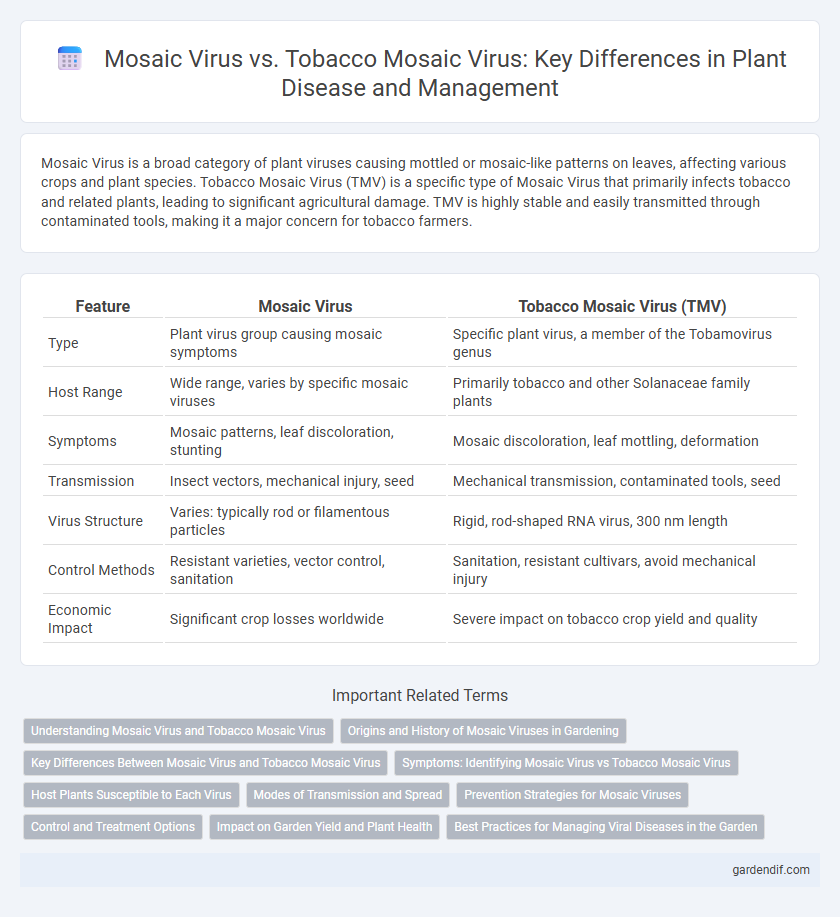
Mosaic Virus vs Tobacco Mosaic Virus Illustration
Mosaic Virus is a broad category of plant viruses causing mottled or mosaic-like patterns on leaves, affecting various crops and plant species. Tobacco Mosaic Virus (TMV) is a specific type of Mosaic Virus that primarily infects tobacco and related plants, leading to significant agricultural damage. TMV is highly stable and easily transmitted through contaminated tools, making it a major concern for tobacco farmers.
Table of Comparison
| Feature | Mosaic Virus | Tobacco Mosaic Virus (TMV) |
|---|---|---|
| Type | Plant virus group causing mosaic symptoms | Specific plant virus, a member of the Tobamovirus genus |
| Host Range | Wide range, varies by specific mosaic viruses | Primarily tobacco and other Solanaceae family plants |
| Symptoms | Mosaic patterns, leaf discoloration, stunting | Mosaic discoloration, leaf mottling, deformation |
| Transmission | Insect vectors, mechanical injury, seed | Mechanical transmission, contaminated tools, seed |
| Virus Structure | Varies: typically rod or filamentous particles | Rigid, rod-shaped RNA virus, 300 nm length |
| Control Methods | Resistant varieties, vector control, sanitation | Sanitation, resistant cultivars, avoid mechanical injury |
| Economic Impact | Significant crop losses worldwide | Severe impact on tobacco crop yield and quality |
Understanding Mosaic Virus and Tobacco Mosaic Virus
Mosaic Virus refers to a group of plant viruses characterized by mottled or mosaic-like patterns on leaves, causing significant damage to crops. Tobacco Mosaic Virus (TMV) is a specific type of mosaic virus that primarily infects tobacco plants but also affects tomatoes, peppers, and other solanaceous crops, leading to stunted growth and yield loss. Understanding the molecular structure and transmission methods of Tobacco Mosaic Virus aids in developing resistant plant varieties and effective disease management strategies.
Origins and History of Mosaic Viruses in Gardening
Mosaic viruses, first documented in the late 19th century, represent a diverse group of plant pathogens causing characteristic mottling and discoloration in leaves. Tobacco Mosaic Virus (TMV), identified in 1892 as the first virus ever discovered, specifically affects tobacco and other solanaceous plants, marking a pivotal moment in virology and plant pathology. Gardeners have historically struggled with mosaic viruses due to their efficient transmission via mechanical means and contaminated tools, leading to significant crop losses and ongoing research for resistant plant varieties.
Key Differences Between Mosaic Virus and Tobacco Mosaic Virus
Mosaic virus refers to a group of plant viruses causing mottled patterns and discoloration on leaves, affecting various crops like cucumbers, tomatoes, and beans, whereas Tobacco Mosaic Virus (TMV) specifically infects tobacco and related plants, causing characteristic mosaic-like symptoms. TMV is one of the most studied and well-known mosaic viruses, notable for its rod-shaped virions and stability, while other mosaic viruses differ in host range, structure, and genetic makeup. The key differences lie in host specificity, viral morphology, and molecular properties, with TMV serving as a model organism in plant virology research.
Symptoms: Identifying Mosaic Virus vs Tobacco Mosaic Virus
Mosaic Virus symptoms typically present as irregular, mottled patterns of light and dark green on leaves, often accompanied by leaf distortion and stunted growth. Tobacco Mosaic Virus (TMV) symptoms include a characteristic mosaic mottling of the leaf surface, yellowing, and necrotic lesions primarily on tobacco and related plants. Differentiating between Mosaic Virus and TMV relies on host range, symptom severity, and specific molecular diagnostics such as ELISA or PCR assays.
Host Plants Susceptible to Each Virus
Mosaic Virus infects a wide range of host plants, including cucurbits, legumes, and some ornamental species, causing mottled or distorted leaves. Tobacco Mosaic Virus specifically targets tobacco plants but also affects tomatoes, peppers, and other solanaceous crops, leading to characteristic mosaic patterns and reduced yield. Both viruses disrupt chlorophyll production, but their host specificity influences the agricultural crops at risk.
Modes of Transmission and Spread
Mosaic Virus primarily spreads through infected seeds, mechanical injury, and contaminated tools, facilitating localized crop infection. Tobacco Mosaic Virus (TMV) transmits via sap contact, ornamental plant handling, and infected seedlings, with stability allowing survival in soil and debris for extended periods. Both viruses exhibit rapid spread in closely spaced plantations, emphasizing the need for stringent hygiene and seed selection to control transmission.
Prevention Strategies for Mosaic Viruses
Preventing Mosaic Virus infections involves implementing crop rotation and using virus-free seeds to reduce pathogen spread. Resistant plant varieties, especially those bred for Tobacco Mosaic Virus resistance, significantly lower infection rates in vulnerable crops. Regular field sanitation and removal of infected plants minimize vector transmission, enhancing overall disease control.
Control and Treatment Options
Controlling Mosaic Virus infections requires integrated pest management strategies such as crop rotation, resistant plant varieties, and rigorous sanitation to prevent viral spread by insect vectors. Tobacco Mosaic Virus (TMV) control emphasizes the use of TMV-resistant tobacco cultivars, thorough disinfection of tools, and removal of infected plants to reduce inoculum sources. Chemical treatments are ineffective against these viruses, making prevention and cultural practices essential for managing disease outbreaks.
Impact on Garden Yield and Plant Health
Mosaic Virus causes mottled patterns on leaves and stunted growth, significantly reducing photosynthesis efficiency and overall garden yield. Tobacco Mosaic Virus specifically targets tobacco and related plants, leading to severe leaf discoloration, distortion, and decreased fruit production, critically impairing plant health. Both viruses disrupt nutrient transport and weaken plant immunity, resulting in lower crop quality and increased susceptibility to secondary infections.
Best Practices for Managing Viral Diseases in the Garden
Effective management of viral diseases in the garden, such as Mosaic Virus and Tobacco Mosaic Virus, relies on strict hygiene practices including disinfecting tools and removing infected plants promptly. Utilizing resistant plant varieties and implementing crop rotation reduces viral spread and buildup in the soil. Controlling insect vectors like aphids and whiteflies also minimizes the transmission of these plant viruses, ensuring healthier garden crops.
Mosaic Virus vs Tobacco Mosaic Virus Infographic

 gardendif.com
gardendif.com